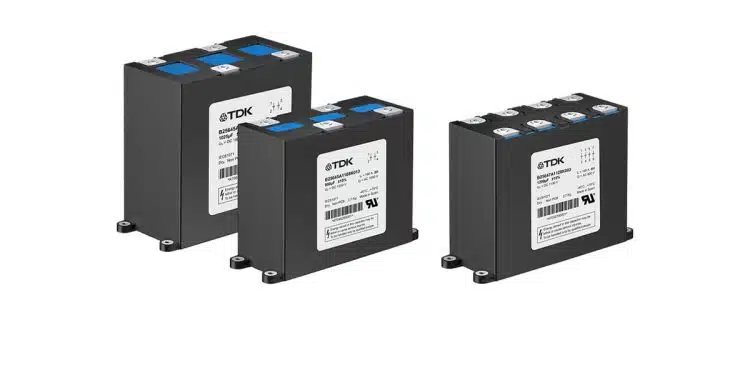TDK Corporation presents ModCapTM HF, a modular, high voltage polypropylene film capacitor concept for DC link applications with ultra low ESL self inductance that is able to work at very high switching frequencies such as SiC-based inverters in traction and renewable energy converters.
The six newly developed power capacitors of the B25647A* series are available for rated voltages from 900 V to 1600 V and cover a capacitance spectrum from 640 µF to 1850 µF. Depending on the type, the rated currents range from 160 A to 210 A with a maximum permitted hot spot temperature of 90 °C.
Thanks to the ultra-low ESL value of only 8 nH and to its flat ESR vs Freq evolution that allows minimizing losses even at high frequency, ModCap HF is particularly well suited for fast-switching SiC-based inverters. The very low self-inductance prevents voltage overshooting on the power semiconductors when the current is shut off. As a result, generally, no snubber capacitors are needed.
In contrast to conventional cylindrical designs, the ModCap HF types are cubic in design with dimensions of 205 x 90 x 170 mm. Thanks to this design, the capacitors fit perfectly to the new generation of power modules improving compactness and maximizing power density.
External materials are fully compliant with fire and smoke standard EN 45545-2 HL3 R23 and UL94 V-0, specially demanded for traction application. UL recognition is especially required by the American market.
Typical applications are compact converters for traction, renewable energies as well as industrial applications with high switching frequencies.
Features
- Modular concept
- Wide voltage range from 900 V to 1600 V
- Wide capacitance range from 640 µF to 1850 µF
- Ultra low ESL (8nH)
- A maximum 90 °C hot spot temperature
- Qualified according to IEC 61071, IEC 61881-1, EN 45545-2 HL3 R23 regarding fire and smoke formation
- UL recognized
Applications
- Compact converters for traction
- Renewable energies
- Industrial applications































